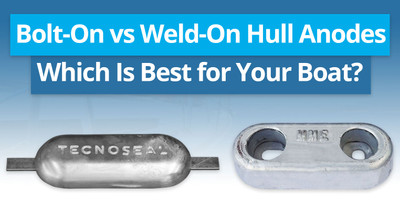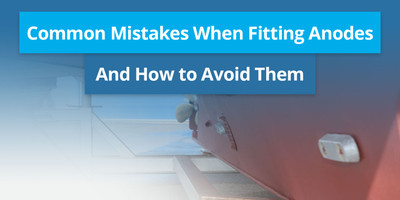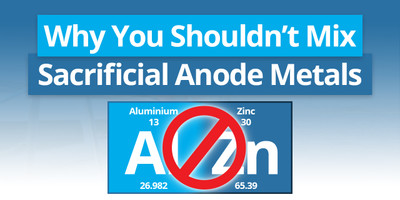15th Aug 2024
Cathodic protection voltages vary depending on material and grade of the metal.
The recommended range of cathodic protection for a vessel depends on hull material and underwater metals is as follows:
Typical Ranges For Cathodic Protection
| Hull Type | Recommended Range |
| Fiberglass w/ Inboard Engine(s) | -750 to -1000 mV |
| Fiberglass w/ Aluminium Outdrive(s) | -900 to 1050 mV |
| Aluminium | -900 to -1100 mV |
| Steel | -800 to 1050 mV |
| Wood | -550 to -600mV |
The pads can also be used on trim tabs, although it is not always necessary if you ensure that the anode core bar itself is clamped to the trim tab, rather than the actual anode material itself.
Fast Anode Erosion
Voltage readings below these ranges (i.e more positive) indicate that underwater metals connected to the bonding system are under-protected and possibly corroding.
Voltages Below The Recommended Ranges
Each underwater metal is protected from corrosion when its cathodic protection system is able to induce and maintain a negative shift of at least 200 mV. For the four most common marine metals this means:
Aluminium (e.g., outdrives, saildrives, hulls)
- Minimum corrosion protection voltage is -900mV
Mild Steel (e.g., hulls, rudders, tanks)
- Minimum corrosion protection voltage is -800 mV
Stainless Steel (e.g., propeller shafts, rudder posts, trim tabs, propellers)
- Minimum protection voltage is -750 mV
Bronze (e.g., propellers, thru hull fittings, seacocks, struts)
- Minimum corrosion protection is -550 mV
If the voltage of one of your underwater metals is less (more positive) than these, you need to check your cathodic protection system. This is usually done by simply replacing depleted anodes.
Causes of Fast Anode Erosion
INCORRECT ANODE METAL FOR WATER TYPE – The first thing to check is that the correct anode is being used for the water type the vessel is moored in. A zinc anode should be used for salt water, aluminium for brackish water and magnesium for fresh water.
NOT ENOUGH ANODE MASS – Rapid wasting of the anode may mean you do not have enough anode material for the component you are trying to protect, or you have a poor quality anode which will not last as long.
STRAY CURRENT ONBOARD – Extremely quick wasting may also indicate an electrical fault on the vessel so this should be checked out. If you are plugged into mains shore power, you are advised to fit a galvanic isolator, which will help block stray currents.
STRAY CURRENT ON MOORING/OTHER VESSELS – Leaving your boat connected to shore power permanently will certainly speed up the process, as will mooring up next to someone who is also connected to shore power and doesn’t have anodes fitted.
CHANGE IN WATER TEMPERATURE/SALINITY LEVELS – Water temperature and salinity also have an effect on the rate at which anodes dissolve so if you take your boat to colder climes, the anodes will last longer. The corrosion rate slows for every 10 degree C (18 degree F) decrease in temperature.
Symptoms of Under Protection
ANODE(S) FALL OFF – anode wasting so severe it falls off completely.
REPLACING ANODES FREQUENTLY – Generally speaking you should replace your anodes when they appear to be half their original size, usually this annually or bi-annually in the UK, but it may be sooner.
ONE PARTICULAR ANODE WEARING MUCH FASTER THAN OTHERS – Some saildrive and propeller manufacturers have simply not allowed for enough mass of anode to protect the drive which means you’ll get through some anode types (saildrive collars/prop nuts) far quicker than expected.
There are many factors that determine how long you anodes will last. If you use the boat longer or if you stay in the water year-round, you will have to change your anodes mid-season. If the boat is used more or if it’s left in the water all year round, it is logical you will need to change the anodes more frequently. If you moor up near a steel bulkhead or near a vessel that has an electrical leak, the anodes will dissolve faster.
*Please note that some engine manufacturers require you to use aluminium anodes within your warranty period
Slow Anode Erosion
Voltage readings above the ranges (i.e more negative) indicate that underwater metals connected to the bonding system are over-protected and causing vessel damage. Cathodic over protection can (almost) be as harmful as under protection. When the anode produces too much current it over protects the more noble metals which cause them to react and produce issues on various boat parts.
Voltages Above The Recommended Ranges:
Over protection can create conditions that damage underwater hull coatings, aluminium alloy metals and wooden hulls.
- Steel and fibre glass hulls – decreased effectiveness of anti-fouling paints and barrier coatings when made more negative than -1100 mV.
- Aluminium hulls and outdrives – highly susceptible to alkali corrosion of its metal, and hydrogen blistering of its paint coatings, when made more negative than -1200 mV.
- Wooden hulls – destruction of wood fibres (alkali delignification) occurs around metal fittings made more negative than -650 mV.
Causes of Slow Erosion
INCORRECT ANODE METAL FOR WATER TYPE – The first thing to check is that the correct anode is being used for the water type the vessel is moored in. A zinc anode should be used for salt water, aluminium for brackish water and magnesium for fresh water.
NOT ENOUGH ANODE MASS – Rapid wasting of the anode may mean you do not have enough anode material for the component you are trying to protect, or you have a poor quality anode which will not last as long.
Common Symptoms Of Over Protection or No Protection
NOT CHANGING ANODES FOR YEARS – If a white crust covers the anode, it probably isn’t doing its job. Aluminium will typically last much longer than zinc but wear shows as craters. Zinc will passivate over in fresh and brackish water becoming relatively inert, which is why it is only used in salt water conditions. Aluminium will not work as effectively as magnesium in fresh water, but will reactivate once more salinity is present, unlike zinc.
PAINT BLISTERING – The hydrogen blistering of paint occurs because the adhesion between the coating and the base to which it was applied (or substrate) is being destroyed. This can be often be seen near where zinc anodes are attached to fibreglass hulls. The process of blistering is referred to as “cathodic disbondment”.
Paint blistering on wooden or metallic hulls can also be caused by alkali attack. Over protection can lead to the formation of alkaline conditions on metallic hulls when there is insufficient flow of water to return the water to its natural pH, resulting in accelerated corrosion. This problem can be enhanced as the paint blisters whereby creating an even more alkaline condition which leads to more rapid deterioration of the submerged metal.
LOSS OF ANTIFOUL OR PROP COATINGS – Similar symptoms to paint blasting, mean the anti fouling and propeller coatings lose adhesion. This is due to incompatibility of the coating application with sacrificial anodes. This can render the anti fouling or coating ineffective and sees increased barnacle and other marine growths. This can lead to vessel inefficiencies due to the drag on the boat and costly manual maintenance.
MARINE GROWTH LURE – Excessive cathodic protection accelerates the formation of calcareous deposits including the calcium carbonate coral-like structure commonly encountered on a vessel’s hull, rudders and propellers.
WOOD ROT – ELECTRO CHEMICAL DECAY – The cellulose in wood is a natural polymer which gives wood its strength. Cellulose is a major component of wood where lignin holds the cellulose together. Over protection resulting from the galvanic current flowing between the anode and cathode destroys the lignin and thus the effects of wood rot are often seen. It is often known as Electro Chemical Decay.
If you are noticing that your vessel is experiencing any of these issues, it would be worth getting your connectivity checked with a multi-meter.



